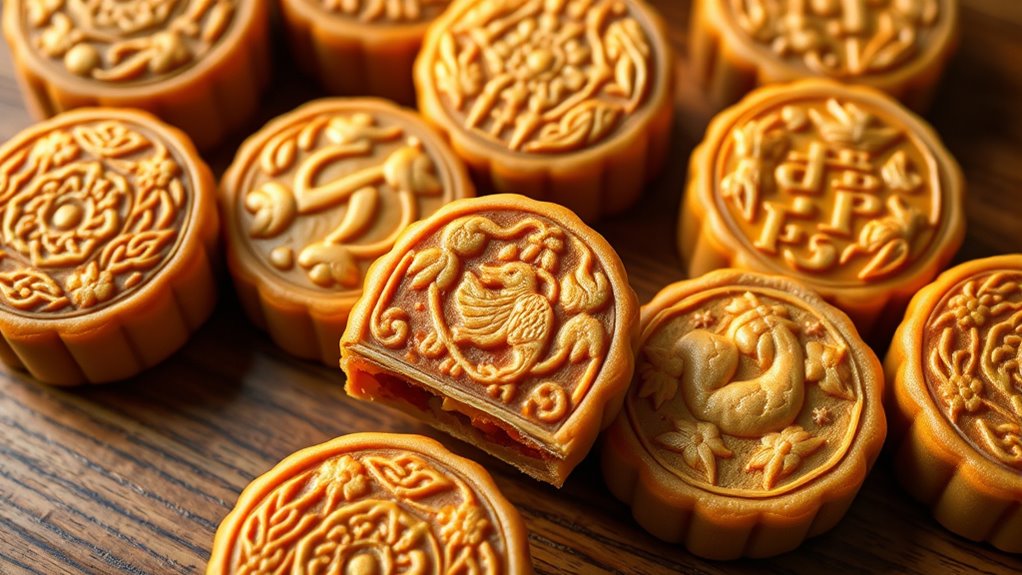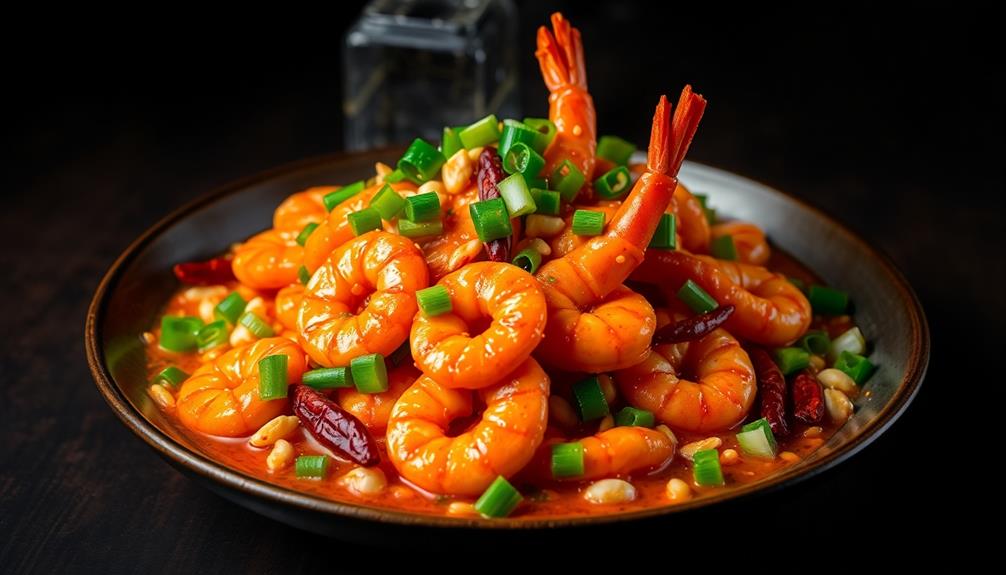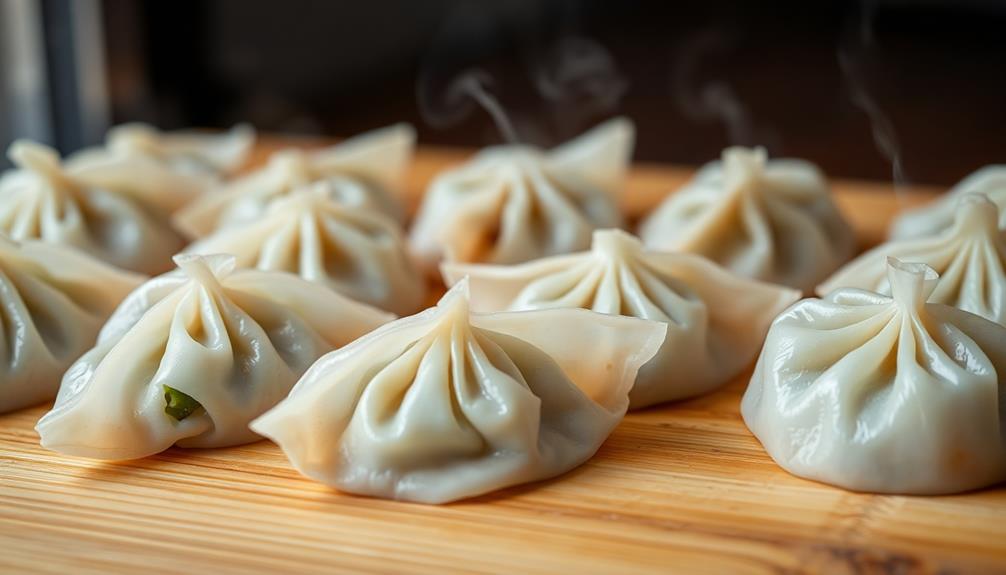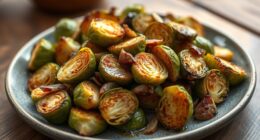Chinese mooncakes have a deep cultural history rooted in celebrating reunion and harmony during the Mid-Autumn Festival. Regional flavors, like lotus seed paste in the north and red bean in the south, showcase local ingredients and traditions. The craftsmanship behind each mooncake reflects centuries of customs, blending history with modern innovation. Exploring these differences reveals China’s rich culinary diversity and the enduring significance of mooncakes. If you want to uncover more about their fascinating background and regional variations, keep exploring.
Key Takeaways
- Mooncakes symbolize reunion, harmony, and cultural continuity rooted in centuries-old Mid-Autumn Festival traditions.
- Regional fillings like lotus seed paste and red bean reflect local ingredients, culinary history, and cultural influences.
- Traditional and modern mooncake styles showcase regional craftsmanship, aesthetic preferences, and evolving tastes.
- Mooncakes serve as edible symbols connecting contemporary celebrations with historical customs and shared values.
- Technological advances and contemporary trends blend tradition with innovation, highlighting the dynamic cultural history of mooncakes.

Chinese mooncakes are a traditional treat enjoyed during the Mid-Autumn Festival, symbolizing reunion and harmony. As you partake in this cultural celebration, you’ll notice how deeply mooncakes are woven into festive traditions. From family gatherings to community events, sharing mooncakes signifies unity and good fortune. These pastries are more than just a sweet snack; they embody centuries of cultural meaning and social customs. When you observe the act of giving and receiving mooncakes, you connect with a tradition that has persisted for generations, reflecting the importance of family, respect, and community cohesion.
Sharing mooncakes during the Mid-Autumn Festival symbolizes unity, tradition, and the enduring spirit of family and community.
The variety of fillings you encounter highlights the rich regional flavors across China. In northern regions, you might find mooncakes with a dense, sweet lotus seed paste, sometimes embedded with salted egg yolks for added richness. Moving south, you could encounter mooncakes with red bean paste, which is smooth and subtly sweet, representing the softer, more delicate taste preferences of that area. Meanwhile, in regions like Guangdong, the tradition emphasizes intricate, flaky pastry shells and a diverse array of fillings, such as mixed nuts, ham, or even savory options. These regional flavors reveal local ingredients, culinary techniques, and cultural influences, making each mooncake a unique expression of its place of origin. Additionally, the technological advances in baking and culinary innovation have led to modern variations, blending tradition with contemporary tastes.
The regional customs around mooncake preparation and gifting further highlight the cultural diversity within China. Understanding these regional differences deepens your appreciation for the diversity of culinary traditions that influence mooncake fillings and preparations. For example, some areas emphasize handmade artistry, while others incorporate modern packaging or flavors to appeal to contemporary preferences. Exploring these variations allows you to appreciate the cultural significance that each regional style brings to the festival.
Understanding the cultural history of mooncakes and their fillings helps you appreciate their significance beyond the festive table. They serve as edible symbols of history, regional diversity, and shared cultural values. Whether you prefer the traditional flavors or modern adaptations, you’re participating in a tradition that embodies harmony, celebration, and regional uniqueness. As you enjoy your mooncake, remember that each bite connects you to a centuries-old story of regional flavors, festive customs, and the enduring spirit of reunion that the Mid-Autumn Festival celebrates.
Frequently Asked Questions
How Have Mooncake Recipes Evolved Over China’s Dynasties?
You’ll notice that mooncake recipes have evolved markedly over China’s dynasties. Historical flavor variations emerged as ingredients and techniques changed, reflecting regional tastes and available resources. Imperial recipe influences also played a role, introducing luxurious fillings like lotus seed and salted egg yolk. Today, modern chefs blend tradition with innovation, creating new flavors while honoring age-old customs, making mooncakes a symbol of cultural continuity and creativity across generations.
What Are the Symbolic Meanings Behind Different Mooncake Ingredients?
You might notice that different mooncake ingredients carry rich symbolic meanings rooted in Chinese culture. For example, lotus seeds symbolize purity and fertility, while salted egg yolks represent harmony and unity. These symbolic ingredients reflect cultural significance, often conveying wishes for prosperity, happiness, or good fortune. By choosing specific fillings, you connect with traditions and express well-wishes, making mooncakes more than just treats—they embody cultural values and hopes.
How Do Regional Fillings Reflect Local Cultural Influences?
You see how regional fillings in mooncakes showcase local flavor profiles and culinary adaptation. Different areas incorporate ingredients unique to their environment and tastes, reflecting cultural influences. For example, sweet lotus seed paste is popular in the south, while savory options like ham and salted egg are favored in the north. These regional variations highlight how communities adapt traditional recipes to express their local identity and culinary heritage.
Are There Any Traditional Mooncake Festivals Besides the Mid-Autumn Festival?
You might wonder if there are alternative festival celebrations beyond the Mid-Autumn Festival. While it’s the most prominent, some regions celebrate local festivals with unique customs, including regional mooncake customs. For example, the Dragon Boat Festival features rice dumplings instead of mooncakes, but in some areas, other events incorporate mooncakes into their traditions. These celebrations highlight local culture, offering a rich tapestry of alternative festival customs related to mooncakes.
How Do Modern Health Trends Impact Traditional Mooncake Fillings?
Imagine mooncakes in a world where health-conscious ingredients and sugar reduction trends dominate. Today, you notice how these trends influence traditional fillings, pushing bakers toward natural sweeteners and lighter ingredients. You see less lard and more nuts or dried fruits, making mooncakes healthier without sacrificing flavor. This shift reflects a growing awareness of wellness, ensuring that tradition evolves to meet modern health standards while still celebrating cultural heritage.
Conclusion
As you savor each bite of a mooncake, imagine a tapestry woven with centuries of tradition, flavors dancing like lanterns in the night sky. From sweet lotus to savory ham, each filling tells a story of regional pride and ancient customs. These pastries aren’t just dessert; they’re a bridge to China’s rich cultural heart, a timeless whisper of moonlit festivals that invites you to taste history itself, one delicious slice at a time.










